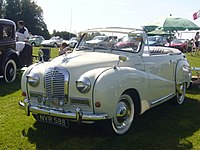
The Ford Zephyr is an executive car manufactured by Ford of Britain from 1950 until 1972. The Zephyr and its luxury variants, the Ford Zodiac and Ford Executive, were the largest passenger cars in the British Ford range from 1950 until their replacement by the Consul and Granada models in 1972.
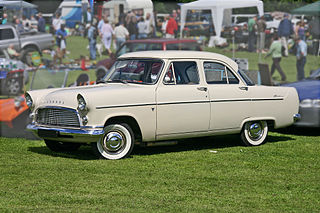
The Ford Consul is a car that was manufactured by Ford of Britain from 1951 until 1962. The name was later revived for a model produced by Ford in both the UK and in Germany from 1972 until 1975.

The Rolls-Royce Silver Cloud is a luxury automobile produced by Rolls-Royce Limited from April 1955 to March 1966. It was the core model of the Rolls-Royce range during that period. The Silver Cloud replaced the Silver Dawn and was, in turn, replaced by the Silver Shadow. The John P. Blatchley design was a major change from the pre-war models and the highly derivative Silver Dawn. As part of a range rationalisation, the Bentley S1 was made essentially identical, apart from its radiator grille and badging.
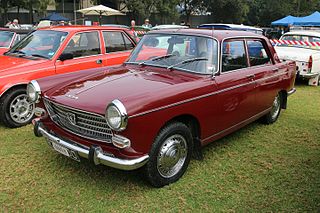
The Peugeot 404 is a large family car produced by French automobile manufacturer Peugeot from 1960 to 1975. A truck body style variant was marketed until 1988. Styled by Pininfarina, the 404 was offered initially as a saloon, estate, and pickup. A convertible was added in 1962, and a coupé in 1963. The 404 was fitted with a 1.6 litre petrol engine, with either a Solex carburetor or Kugelfischer mechanical fuel injection or a 1.9 litre diesel engine available as options. Introduced at the Paris Motor Show as an option was the inclusion of a 3-speed ZF automatic transmission, similar to the unit already offered on certain BMW models, as an alternative to the standard column-mounted manual unit.

The Austin A90 Atlantic is a British car produced by the Austin Motor Company from 1949 until 1952. It was launched initially as a four-seat convertible, making its début at the 1948 Earls Court Motor Show in London, with production models built between early 1949 and late 1950. A two-door coupé, marketed as the A90 Atlantic sports saloon, followed a year later. It had been previewed at the 1949 Motor Show and was in production at Longbridge between 1950 and 1952.

The Austin A30 is a small family car produced by Austin from May 1952 to September 1956. It was launched at the 1951 Earls Court Motor Show as the "New Austin Seven" and was Austin's competitor with the Morris Minor.

The Austin A40 Farina is a small, economy car introduced by Austin in saloon (1958) and A40 Countryman (1959) estate versions. It has a two-box body configuration. It was badged, like many before it, as an A40, consistent with Austin's naming scheme at the time, based on the approximate engine output in horsepower; and to distinguish it from other A40 models, it was also given a suffix name – this one being the Farina, reflecting the all-new design by Italian Battista Farina's Pinin Farina Turin studio.
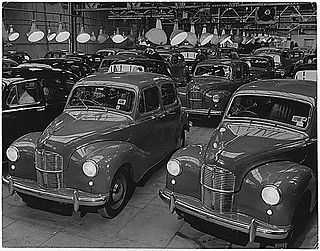
A number of different automobiles were marketed under the Austin A40 name by Austin between 1947 and 1967.

The A40 Devon are automobiles that were marketed by Austin from 1947 to 1952 – the first post-war saloons to be produced by Austin – featuring a mix of old and new technologies. They were previewed by the UK press at the Paris Motor Show on 22 October 1947, who expressed immediate disappointment at the car's conservative appearance. More than 450,000 were built before the model's replacement in 1952 by the Austin A40 Somerset.

The Austin A40 Sports debuted at the 1949 London Motor Show at Earls Court as a four-passenger, aluminium-bodied convertible variant of the Austin A40 – carrying an Austin of England nameplate, bearing Austin's Flying A hood ornament, and designed and manufactured in conjunction with Jensen Motors.

The Austin Cambridge is a medium-sized motor car range produced by the Austin Motor Company, in several generations, from September 1954 through to 1971 as cars and to 1973 as light commercials. It replaced the A40 Somerset and was entirely new, with modern unibody construction. The range had two basic body styles with the A40, A50, and early A55 using a traditional rounded shape and later A55 Mark IIs and A60s using Pininfarina styling.

The Austin A70 Hampshire and later Austin A70 Hereford are cars that were produced by Austin of Britain from 1948 until 1954. They were conventional body-on-frame cars with similar styling to the smaller A40 Devon and A40 Somerset models respectively, though with an entirely different larger and wider body on chassis construction. 85,682 were built.

The Austin Westminster series are large saloon and estate cars that were sold by the British manufacturer Austin from 1954, replacing the A70 Hereford. The Westminster line was produced as the A90, A95, A99, A105, and A110 until 1968 when the new Austin 3-Litre took its place. Essentially badge-engineered versions of the Farina Westminsters were also produced using the premium Wolseley and Vanden Plas marques. 101,634 Westminsters were built.

The Fiat 1400 and Fiat 1900 are passenger cars produced by Italian automotive manufacturer Fiat from 1950 to 1958 and from 1952 to 1959 respectively. The two models shared body and platform, but while the 1.4-litre 1400 was Fiat's intermediate offering, the upmarket 1900 had an enlarged 1.9-litre engine and more luxurious trim and equipment, to serve as flagship in the manufacturer's range.

The Standard Vanguard is a car which was produced by the Standard Motor Company in Coventry, England, from 1947 until 1963.

The Jowett Jupiter is a British sports car which was produced by Jowett Cars Ltd of Idle, near Bradford.

The Vauxhall Velox is a six-cylinder executive car which was produced by Vauxhall from 1948 to 1965. The Velox was a large family car, directly competing in the UK with the contemporary six-cylinder Ford Zephyr, and to a slightly lesser extent, with the A90, A95, and A110 Austin Westminster models.
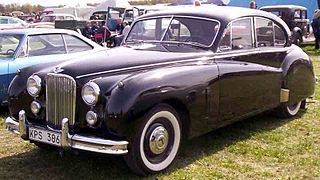
The Jaguar Mark VII is a four-door luxury car produced by Jaguar Cars of Coventry from 1951 to 1956. Launched at the 1950 British International Motor Show as the successor to the Jaguar Mark V, it was called the Mark VII because there was already a Bentley Mark VI on the market. A version of the Jaguar Mark V with the XK engine had been designated as the Mark VI, but it is thought that only two were built.
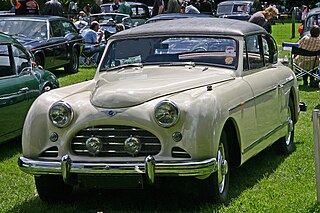
The Jensen Interceptor made its debut in 1950 as the second car made by Jensen Motors after World War II. The car was based on Austin components with a body built by Jensen and styled by Eric Neale. The 3,993 cc straight-six engine and transmission came from the Austin Sheerline and the chassis was a lengthened version of the one used on the Austin A70 with a modified version of the independent coil sprung suspension.

The Sunbeam-Talbot 90 is an automobile which was produced and built by Sunbeam-Talbot from 1948 to 1954 and continued as the Sunbeam Mk III from 1954 to 1957.




